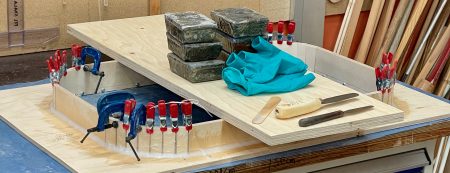To increase seaworthiness I am adding an airlock. There is a video below showing the start.
I use the fore and after peak as airlocks.
I will fit these relatively small spaces with two watertight hatches in series.
Captain Nemo had one on his submarine Nautilus 1869 so the idea is not new. Nowadays its common on submarines and spaceships but not on small cruisers.
I endeavor to make my small cruiser as seaworthy as possible. From the hatches I can reach the masts and sails. Those I do not have to be on deck to reef and unreef. A good thing if I should get old and week. In high latitudes there is the possibility of waves filling the fore or after peak when the hatches are open. Now with the peaks in airlock mode no water will enter the living compartments. I can close the hatch, pump out all the water get dry and enter the living compartment.
1973 I left Sweden in an attempt to round Cape Horn in Bris a 20 feet light displacement double ender. The first part of the route took me north of Scotland, west of Ireland similar to my 2020 sail. For several weeks the weather was heavy. At one time a wave hit the beam with such a force that the boat was flung a long distance to lee. When looking out I noticed that the logline was wrapped around the hull. At an other time one dark night when the wind increased I went up to the mast to reduce sail. Looking back I saw an enormous breaker. I only just had time to sit down cross my legs and arms around the mast, because I was sure that when the breaker hit my small boat she would capsize. But as miracle she just held her course and took of in an enormous surf leaving a monster wake behind her for what seamed a very long time.
When I was back below my arms and back ached.
In the beginning of 1974 I left Mar del Plata Argentina bound for Cape Horn. After a few weeks of sailing south Bris was capsized by a wave hitting her beam. The wind was much less strong than the ones I had had in the Northern North Atlantic. A week later. It was early in the day the wind suddenly increased to hurricane force. I did not worry to much because such sudden winds usually die down quick. Not this one. It just kept blowing with the same intensity for hour after hour. All sails was down and a drouge was streamed om a 150 meter long line. Despite that Bris was pichpoled.
I designed a more seaworthy boat, but it was a long way to my mothers basement where I had built Bris.
An important part was the ventilation system. When Bris had been upside down water had entered. To prevent that from happening again I made the air enter at the bottom of the boat. When the boat is upside down the boats bottom is up in the air hence no water can enter in a capsize or pitchpole. The system works very well and I have written more about it in the manifesto.
Now 2021, 47 years later I am still finding ways to make my boats more seaworthy.
I now had two shots of vaccin I hope to be back in Porto Santo Madeira very soon to do some sailing in the deep, big, blue, eternal, endless, ocean, before I continue working on the Canoe Yawl in the autum. But even though I am vaccinated it seams that I have to get a corona test and that will cost € 200. I try to find a cheaper way.
Below a picture of the what is the start of the coaming.

The airlock video belov. Please comment, subscribe, donate and enjoy.
To be continued…
Regards Yrvind.
